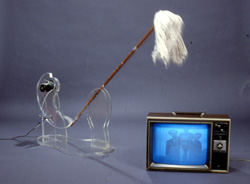

 Carolee Schneemann has long been one of those pioneer American artists whose work is more often written about and referred to than actually shown and viewed. Part of the explanation for this automatic exclusion from most historical overviews is that Schneemann’s work, like so many of the other pioneers in the field of interdisciplinary art, challenged the reigning male hegemony in the art world with such totality that it is often difficult to find any common ground between her work and that of some of her better-known male colleagues (and collaborators) from the 1960s. Since most of the public collections perceived as being repositories of the canonical works of modern art have substantial investments in art by those contemporaries, to recognize Schneemann as one of their peers would be to introduce some fundamental challenges to modernism at a moment when it reigned supreme in the New York art world.
Carolee Schneemann has long been one of those pioneer American artists whose work is more often written about and referred to than actually shown and viewed. Part of the explanation for this automatic exclusion from most historical overviews is that Schneemann’s work, like so many of the other pioneers in the field of interdisciplinary art, challenged the reigning male hegemony in the art world with such totality that it is often difficult to find any common ground between her work and that of some of her better-known male colleagues (and collaborators) from the 1960s. Since most of the public collections perceived as being repositories of the canonical works of modern art have substantial investments in art by those contemporaries, to recognize Schneemann as one of their peers would be to introduce some fundamental challenges to modernism at a moment when it reigned supreme in the New York art world.
With the gradual shift in stylistic priorities in American art over the past ten or fifteen years – a shift that has witnessed a heightened emphasis on performance, video, multi-media installation, and interdiscilinary practice – a piecemeal reevaluation of Schneemann’s work is slowly but inexorably taking place. The history of performance now features her as a major figure, as does the history of experimental film, in which her efforts during the early 1960s figure prominently. A new generation of feminists see her example as breathtakingly courageous, and her steady five-decade flow of writings about art have begun to find a broader public than ever before.
Three distinct works from different periods of Schneemann’s career make up her contribution to the Taipei Biennial, but the three are invariably linked through the shared reference to violence and war. Viet Flakes, a mid-1960s Super 8 film (transferred to DVD), demonstrates by example how easily a montage of death and destruction can segue into yet another parable about the miracle of the American lifestyle. In War Mop, a video tableau from the early 1980s, Schneemann’s equally stern video indictment of the Israeli invasion of Lebanon is accompanied by an incessant beating of an ordinary kitchen mop over the top of the video monitor. These two quite graphic reports of war are accompanied, not by more war footage, but by the silent accusation implied by blow-ups of still photographic images of domestic cats trapped in cages, as a form of assertion that inhumanity to any sentient species is a form of inhumanity to us all.